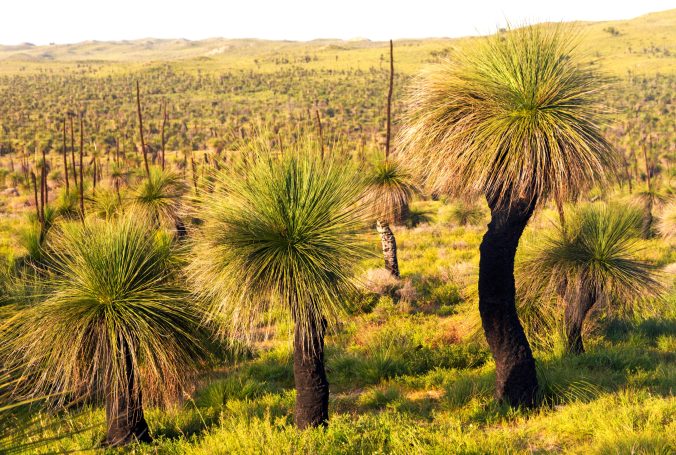Perennial, flowering plants with some species growing to six metres tall.
Grass trees (Xanthorrhoea) are an endemic Australian genus of 28 species, only a few of which grow substantial above-ground stems. They are iconic perennial, flowering plants with the smallest species growing to about a metre and others reaching 6 metres tall.
Grass trees have a unique structure, with a true stem of fibrous conducting tissue supported by a sheath of tightly packed old leaf bases glued by a reddish crystalline resin.
Hundreds of very narrow, hard-textured leaves radiate from the apex of each branch. Tall, rodlike flower spikes grow above the foliage, and then numerous tiny white flowers emerge from densely packed brown bracts.
Most grass tree species are extremely slow growing. Studies of some of the taller species found that trunk height increases at about 0.8 cm to 6 cm per year, but this varies with local environmental conditions. In any event, grass trees are often very long-lived – some are estimated to be 350 to 450 years old.
Grass tree leaves are narrow, linear and stiff. Old leaves often hang down and form a ‘skirt’ around the base of the trunk. The length of the skirt is a good indication of the time since the last fire – the longer the skirt, the longer the duration without fire.
Grass trees are highly fire resistant, and are among the first to respond after a wildfire. Fires may burn their leaves and blacken their trunks, but the trees usually survive as the living growth point is buried underground, protected by tightly packed leaf bases. In fact, some grass tree species are stimulated by fire – in the spring after a summer wildfire, large numbers of plants often flower.
Grass trees may take several years to flower. Flowers form on a spear-like spike, which can be up to 4m long. Flowers are arranged in a spiral up the spike, and produce a great amount of nectar, attracting a wide variety of insects, birds and mammals.
The grass tree is important to Aboriginal people across Australia. Its resin was traditionally used as glue in spear-making and in patching up water containers. Flower spikes make fishing spear shafts and firesticks; the tough seed pods are used as cutting implements, and the flower’s nectar forms a sweet, slightly fermented drink.
Grass trees are also known as “yacca”, which is likely derived from a South Australian Aboriginal language, mostly likely “kaurna”.
Grass trees are found in all Australian states and territories, especially on the east and west coasts. The Austral grass tree (Xanthorrhoea australis) is one of the most widely distributed species, growing in Tasmania, Victoria, NSW, ACT and South Australia.
Populations of some species of grass tree have been devastated by the Cinnamon fungus. This fungus rots the roots of grass trees and causes dieback. The disease caused by this introduced plant root pathogen is often difficult to detect and, more worryingly, its impact may be considerable before being detected.
Further threats to grass trees include land clearance for agriculture and urban development; inappropriate burning; overharvesting of foliage and illegal removal of the plants from their natural habitat for sale as popular garden plants.
